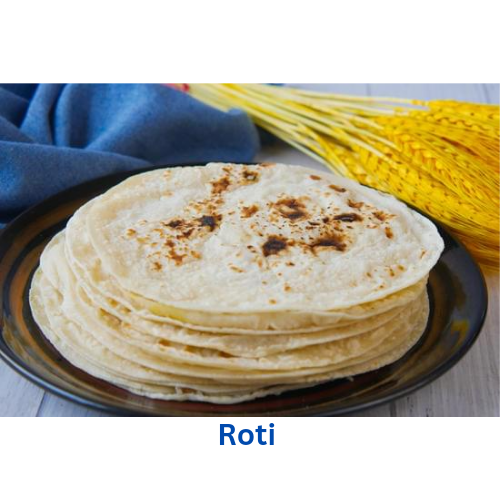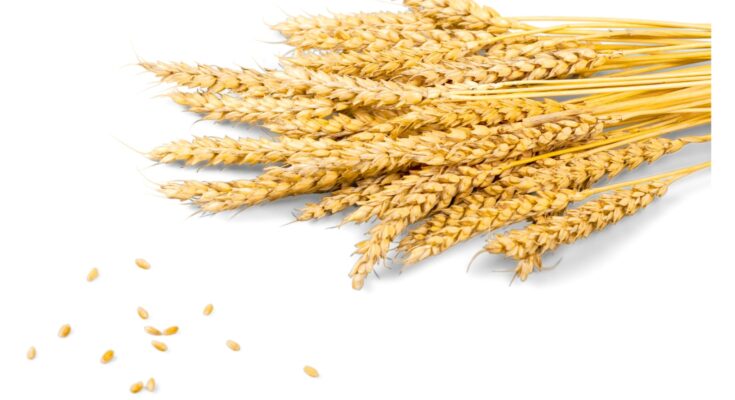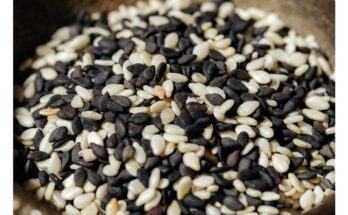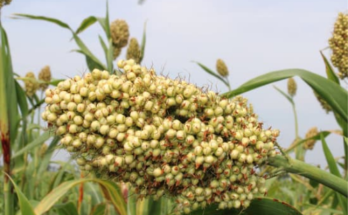Wheat belongs to the genus Triticum of the grass family Gramineae. The genus is further subdivided into a number of species, which can be classified into types according to the number of pairs of chromosomes they contain: diploid (7 pairs), tetraploid (14 pairs) and hexaploid (21 pairs). The hexaploid type is the major class of wheat, known as “common” wheat, whereas the tetraploid wheats are known as “durum” wheats.
Wheat as the most important of the cereal grains, today provides more nourishment for the people than any other food. The golden grain is the main source of protein and dietary fibre for large segment of population.
Nutritive value per 100g of Wheat:
Energy (kcal) : 346
Protein (g) : 11.8
Fat (g) : 1.5
Carbohydrates (g) : 71.2
Crude Fibre (g) : 1.2
Vitamins:
Carotene (µg) : 64
Thiamine (mg) : 0.45
Riboflavin (mg) : 0.17
Niacin (mg) : 5.5
Folic Acid – Total (µg) : 36.6
Minerals (g) : 1.5
Calcium (mg) : 41
Phosphorus (mg) : 306
Iron (mg) : 5.3
Magnesium (mg) : 138
Sodium (mg) : 17.1
Potassium (mg) : 284
The endosperm contains the starch granules in a protein matrix that are separated from the bran during milling to produce white flour, together with the aleurone layer, which makes up the outer part of the endosperm.
The wheat grain (or kernel) can be divided into three distinct morphological parts : the endosperm, which makes up most of the grain; the bran layer, which surrounds the grain; and the germ, which includes the embryo and the scutellum. The kernel of wheat is a store house of nutrients needed and used by man since the dawn of civilization.
Prior to functional use, wheat grains are subjected to milling process to separate out bran and germ from endosperm, which yields a variety of flours for end use (for preparation of Roti, Bread, Cakes, Pasta etc). Wheats are generally classified according to the colour and hardness of grain. Hard wheats yield flour that is higher in good quality protein. Such flours have high water absorption power, good mixing and fermentation tolerance, good gas retention power and are excellent for bread making. Soft wheats have lower amount of proteins and absorb less water and are used for cakes, soft dough biscuits and cookies. Durum wheats are used for production of semolina which is the major raw material for pasta products. Therefore, wheat i.e. durum, hard and soft, differing in protein contents has specific uses for the preparation of different products.

Quality of wheat
Quality is a subjective term that describes different meanings to different people in the grain trade. Physical quality and functional quality are considered important. Physical quality refers to test weight, impurities, damaged grains, moldy grains, heat damaged grains, grains attacked by pests and shrivelled grains whereas functional quality refers to specific end use quality or specific requirement of buyers for different end products.
The criteria of grain quality may also be defined by botanical, physical and chemical characteristics.
The grain characteristics such as varietal purity, soundness and vitreousness and grading factors such as foreign material (any thing other than grain that remains in the sample after removal of dockage/waste material) are determined.
The grains meant for grinding/processing shall be clean, free from all impurities including foreign/extraneous matter.
The quality of wheat is usually judged by its suitability for a particular end use. All wheats are used primarily for human food and are milled either to a flour or to a granular product such as semolina. Other forms such as breakfast cereals, chapaties and whole wheat bread are also common in various countries. During the milling of wheat to refined flour, bran and germ are separated and are used as animal feed. Apart from soil, climate and inherent properties, the wheat under goes deterioration as a result of improper handling or storage or it contains too much foreign material. Bright, sound, fully matured, clean wheat free from foreign material or any evidence of damage, is preferred for food usage. Wheat quality is closely related to the quality of milled products particularly flour.
I. Botanical criteria of quality
(a) Species: Out of about 15 sp. Only 3 are important
T. compactum – 42 chromosomes
Triticum aestivum – 42 chromosomes
T.durum – 28 chromosomes
(b) Varieties: Varietal differences are found in the same category of wheats. Although the varieties are important factor influencing wheat quality but it is seldom marketed on the basis of individual variety. Wheats are segregated according to classes or grades which cover several varieties and have common use for a similar purpose.
II. Physical criteria of quality
Weight per unit volume: It is the most widely used for describing test weight of any wheat. It may be described as hectoliter weight which means the weight of wheat which can be adjusted in 100 litres of volume. Higher test weight wheats generally yield more flour than wheats of lower test weight. It gives rough idea for milling yield.
Kernel weight: Usually expressed in terms of weight per 1,000 kernels, is a function of kernel size and density. Large and dense wheat kernels have higher proportions of endosperm than less dense kernels. Kernel weight is more reliable than test weight for judging the milling yield of any wheat. Higher kernel weights suggest good quality of wheat.
Kernel size and shape: Kernel size is related to kernel weight and is index of flour yield. Different varieties differ in the size of grains. Grading is also done on the basis of size and shape. Kernels are passed through the sieves and overs are determined.
Kernel hardness: Hardness is considered in the classification of wheat for grading purposes. Hardness is measured by determining ‘Pearling index’ defined as the percentage of material pearled-off from a wheat sample in a laboratory barley pearler for a prescribed time.
Vitreousness: Grains may be vitreous or mealy depending upon the hardness of grain and these properties are used for the classification of different grains. Hard grains usually have high protein content (vitreous) but it is a subjective method and gives rough index of protein content.
Colour: Wheat may be red, amber or white depending upon the colour of bran. Red wheats are predominant wheats and are dark in colour, tend to be harder, have high protein content and are suitable for bread making.
Damaged kernels: Wheat may be damaged due to many reasons in the field before harvesting (bad weather, disease, frost, heat damage, insect, mold, sprout damage) or during drying, storage and handling. Frost may cause discolouration and affects flour yield. Excessive beating may injure the gluten quality. Breakage occurs during threshing and the broken grains are not accepted by miller as it poses difficulty in conditioning of grain (‘sick wheat”). During storage insect infestation causes reduction in flour yield.
Impurities: The quantity of extraneous matter in wheat is the important criteria of wheat quality. Sand, dust, pebble, paddy, seeds, weeds and broken kernels are included under impurities. “Dockage” term used in USA for the foreign material or impurities are the one which can be easily removed by mechanical means. Whereas ‘Besatz’ is the another word used to describe impurities
Milling quality: Test milling is done for the evaluation of wheat for flour yield. Straight grade flour recovery is 72 per cent and that of semolina 58 per cent and is based on clean wheat. Wheat which gives high yield of flour with lower ash content is having good milling quality. Small kernels produce flour with higher ash content.
Buhler Lab mill are mostly used in the test milling of wheat and their yield corresponds with commercial mills.
Sieve analysis: Overtailing of 10 xx and of the sieves above, indicate defects in the sifting of stocks. The tests are carried out in the Buhler Laboratory Plansifter fitted with circular 14 W. 20 W, 32 W, 45 W, 60 W, 6 xx and 10 xx sieves.
III. Chemical criteria of quality
Moisture: Low moisture in the freshly milled flour indicates either insufficient conditioning or excessively dry atmosphere in the mill.
Ash: Higher ash content of flour indicates higher extraction rates and shows the contamination with bran.
Gluten: Weight of wet gluten is an indication of its hydration capacity. Dry gluten is an approximate guide to the protein content of a flour. Higher gluten content is essential in bread flours.
Protein: It is a more accurate measure of the protein content of flour than gluten, though both are important. Higher protein content of flour is associated with higher gluten content. The protein of a flour depends mainly on that of the wheat from which it is milled.
Flour pigments: Freshly milled, unbleached flour appear creamy yellow, due to the presence of yellow pigments. The amount of the pigments depends on the extent of bleaching treatment in the mill and ageing.
Diastatic activity (Maltose figure): ‘Maltose figure’ is a measure of the diastatic activity of a flour, i.e. the capacity of a flour to produce sugar during fermentation and proofing stages in bread doughs. It depends on the amylases existing in the flour and to some extent on the damaged starch granules as a result of milling. For good bread, the ‘Maltose figure of a flour should be between 1.7-2.5 per cent. Low diastatic activity of a flour is associated with poor gas production in the fermenting dough, particularly at the proof stage. Such flours produce bread with pale brown crusts. The diastatic activity can be adjusted by addition of standardized amounts of diastatic malt flour or extract.
Improver treatment: Potassium bromate is extensively used as an improver in bread flours. A content of 10-15 ppm brings about significant improvement in bread baking quality of a flour. The flours of imported wheats generally respond to improver treatment whereas flours of indigenous wheat show variable response.
Dough properties (Farinograph): Brabender Farinograph is used to determine the water absorption, dough development time and stability of the dough when mixed.




